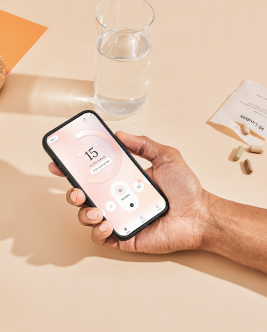nutrition
Should You Take a Multivitamin with Iron? Here's What the Research Says
On This Page

Multivitamins with iron may be useful to people who are at particular risk of iron deficiency. Read on to learn more.
Multivitamins can help our bodies by filling nutrient gaps in our diets. When our bodies have the nutrients they need, we can have a better quality of life. It’s little wonder, then, that an estimated one-third of all American adults take a multivitamin or multimineral. Multivitamin products are very popular and will likely remain so.
However, no single type of multivitamin is for everybody. It all depends on what your particular needs are. That’s why some multivitamins include iron, while some do not. Some people are at higher risk of iron deficiency, and iron deficiency can present a challenging set of potential health concerns. Iron should only be supplemented for people who are not getting adequate iron in their diet. Getting too much iron can be dangerous, so do not supplement with iron unless you have spoken with your doctor. Let’s take a look at what multivitamins are good for and how they ought to be used.
Do multivitamins contain iron?
You will find that some multivitamins contain iron, while others do not. For instance, most prenatal vitamins usually contain iron, although there are still a few out there that don’t. Typically, multivitamins aimed at people born female who are of reproductive age contain iron. This addition is helpful for supporting menstrual and reproductive health in this population.
In contrast, multivitamins aimed at people born male, or people born female who have entered menopause, generally exclude iron. Multivitamins for these populations will likely focus on other vitamins and minerals that are more essential for their current needs.
Why don’t gummy multivitamins contain iron?
The formulation of gummy vitamins depends heavily on texture and taste, aiming to make them more appealing and palatable. So when it comes to iron, this mineral can pose some challenges for gummy vitamins. Iron carries a strong, metallic taste that is more difficult to mask. Integrating it into a gummy vitamin without compromising its taste is a significant hurdle. This is the main reason why gummy multivitamins typically exclude iron from their ingredient list.
What are multivitamins with iron good for?
In order to function at an optimal level, your body needs an adequate intake of vitamins and minerals. That said, most people simply don’t get what they need from their diets. When nutrient gaps exist, vitamin supplements – including multivitamins – can help fill them.
Multivitamins combine a number of different vitamins and minerals that are ordinarily found through dietary means. You can choose a multivitamin based on your specific vitamin needs. Some multivitamins contain iron, which can be useful if you’re one of the many people out there with inadequate iron intake. Iron is a mineral that your body needs to perform various processes. It carries oxygen and red blood cells throughout your body, enabling your body to perform all of its other functions.
Certain people are at greater likelihood of having inadequate iron intake, including kids and infants, people who experience heavy menstruation, people who are pregnant, athletes, and people who donate blood on a frequent basis. Some symptoms of iron deficiency can include fatigue, dizziness, occasional issues with concentrating, and impaired exercise performance. Iron deficiency is typically associated with poor diet, malabsorptive disorders, and blood loss, people with iron deficiency usually have other nutrient deficiencies. If an iron deficiency is determined to be a problem for you, a multivitamin with iron can be part of your solution, helping you to restore your body’s iron stores.
What to know before you start a vitamin routine with a multivitamin with iron
Before you take any iron supplement – including a multivitamin with iron – it’s important to talk to your doctor. Your doctor will want to measure your levels before proceeding because taking too much iron can be toxic.
What should you avoid while taking multivitamins with iron?
Because iron supplements can interact with other medications and supplements in your system, it’s important to exercise caution about how and when you take your multivitamin with iron.
If you are taking antibiotic medications – give yourself 2-hours before or after taking your multivitamin with iron. If you’re taking antibiotics such as levofloxacin, ciprofloxacin, norfloxacin, among others, you should exercise particular caution and speak with your doctor first.
Also, be on the lookout for foods that are known to make iron absorption more difficult for your body. Give yourself a 1 or 2-hour window after eating fish, meat, live, whole grain, and fortified foods before taking your multivitamin with iron. Calcium also makes iron absorption more difficult for your body, so you should avoid taking iron with dairy products or calcium supplements.
Should you take a multivitamin that has iron in it or an iron supplement with a multivitamin?
This is a great question – and before you make a decision, it’s important to consult a medical professional. The key is to know what your iron needs are and what dose is present in the multivitamin compared with the standalone iron supplement. Depending on the amount of iron in the multivitamin with iron, you may be advised to take an iron supplement in addition to the multivitamin. Again, this all depends on your lab values. Your doctor will also want to know the quantities of other nutrients present in any other supplements you’re taking.
How to safely take a daily multivitamin-with-iron supplement
You should never take more than the recommended dose of your multivitamin with iron, as excess iron can be toxic. The key is to avoid unhelpful interactions between the supplements and medications you’re taking. As always, you should talk to your doctor before proceeding.
Potential side effects and contraindications
As we’ve discussed, it’s very possible for other drugs and supplements to have negative interactions with multivitamins with iron. Before using a multivitamin with iron, it’s important to tell your doctor about all the supplements and medications you’re taking. And, once you’ve started taking the multivitamin with iron, it might be a good idea to track your progress to see if the multivitamin is making a difference for you. However, no one single type of multivitamin is for everybody. It all depends on what your particular needs are.
Introducing the Care/of Multivitamin + Iron
The Care/of multivitamin with iron can be especially helpful to people at risk of inadequate iron intake, including people who menstruate. It contains better ingredients – not more ingredients – in easily digestible forms. Since most people’s diets don’t meet the recommended amounts of nutrients, this multivitamin can be a great way to fill dietary gaps. It’s also designed with the most up-to-date research, ensuring maximum effectiveness.
The Bottom Line
Not all multivitamins contain iron, but the ones that do are typically directed towards populations with increased needs for iron – such as people born female who are menstruating and of reproductive age. If you are interested in a multivitamin that includes iron, it’s important to check the label to see whether iron is included in the list of ingredients and what the dosage is.
Always check with your healthcare provider before taking iron. Not everyone needs an iron supplement, and excess levels can lead to toxicity. If you find that you do need iron, choose a type that is highly absorbable and consider pairing it with vitamin C for enhanced absorption.



